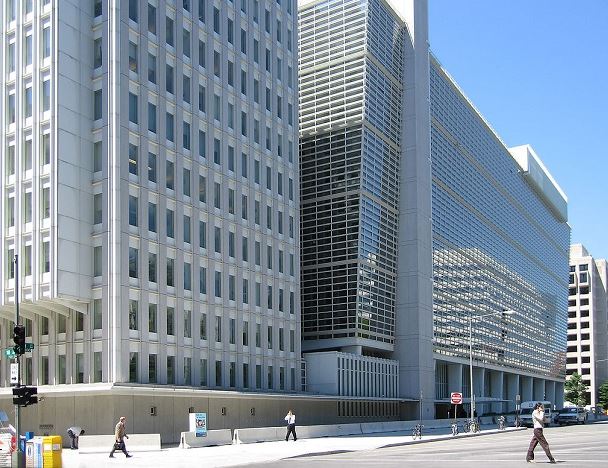
World Bank headquarters in Washington, DC. (Photo: AP)
Washington (People’s Daily) -- The World Bank on Thursday released its latest global economic outlook, which predicts the global economy will grow by a modest 2.5 percent in 2020 despite the challenges of rising debt and slowing productivity growth.
The report forecasts a gradual recovery in investment and trade in 2020, with overall growth in advanced economies falling to 1.4 percent, in part because of continued weakness in manufacturing.
US economic growth will slow to 1.8 percent this year, mainly due to the negative impact of recent tariffs and rising uncertainty. Eurozone industrial activity is weak and growth will fall to 1 percent in 2020.
The World Bank expects growth in emerging market and developing economies to accelerate to 4.1 percent this year, but the rebound is not broad-based, with a third of them expected to slow this year because of weaker than expected exports and investment.
“With growth in emerging and developing economies likely to remain slow, policymakers should seize the opportunity to undertake structural reforms that boost broad-based growth, which is essential to poverty reduction,” said World Bank Group Vice President for Equitable Growth, Finance and Institutions, Ceyla Pazarbasioglu.
“Steps to improve the business climate, the rule of law, debt management, and productivity can help achieve sustained growth.”
The World Bank forecasts that China's economy will grow by 5.9 percent in 2020.
The World Bank believes the outlook for global growth remains dominated by downside risks, including renewed escalation of trade tensions and trade policy uncertainties, sharper than expected declines in major economies and financial turmoil in emerging and developing economies.
Even if growth in emerging markets and developing economies recovers as expected, per capita growth will remain well below its long-term average and far below the level needed to achieve poverty reduction.
The report also highlights four major issues that should be addressed in the current global economy.
One is the dramatic rise in debt. The bank points out that there have been four debt-accumulation binges in the past 50 years. The latest debt binge, which began in 2010, was the largest, fastest and most extensive of the four. While low interest rates have mitigated some of the risks of high debt, the last three broad-based debt binges ended in widespread financial crises.
Once the risk becomes a reality, policy options to reduce the probability of a crisis and its impact include the establishment of a resilient monetary and fiscal policy framework, sound oversight and regulatory mechanisms, and adherence to transparent debt management practices.
“Low global interest rates provide only a precarious protection against financial crises,” said World Bank Prospects Group Director Ayhan Kose. He added that, “In a fragile global environment, policy improvements are critical to minimize the risks associated with the current debt wave.”
The second issue is how to restart productivity growth. Since the international financial crisis, productivity growth has slowed more widely and more sharply than at any time in the past 40 years.
The slowdown in productivity growth in emerging and developing economies reflects the impact of weak investment and slower efficiency gains and less redistribution of resources across industries, as well as a slowdown or stagnation in improvements in many key drivers of labor productivity, including education and institutions.
Third, beware of the side effects of price control. The widespread use of price controls in emerging and developing economies can also hamper investment and growth, undermine poverty reduction, place a heavy fiscal burden on countries, and complicate the effective use of monetary policy.
The bank recommends replacing price controls with expanded and more targeted social safety nets, reforms that encourage competition, and a good regulatory environment that benefits the poor and economic growth.
Fourth, focus on inflation in low-income countries. Inflation in low-income countries has fallen from 25 percent in 1994 to a median of 3 percent by mid-2019. Lower inflation has been driven by a more flexible exchange rate, greater central bank independence, lower government debt and a more favorable external environment.
But to keep inflation low and stable in the context of rising fiscal pressures and the risk of currency shocks, policymakers need to strengthen the monetary policy framework and the ability of banks to replace price controls with more efficient policies.


